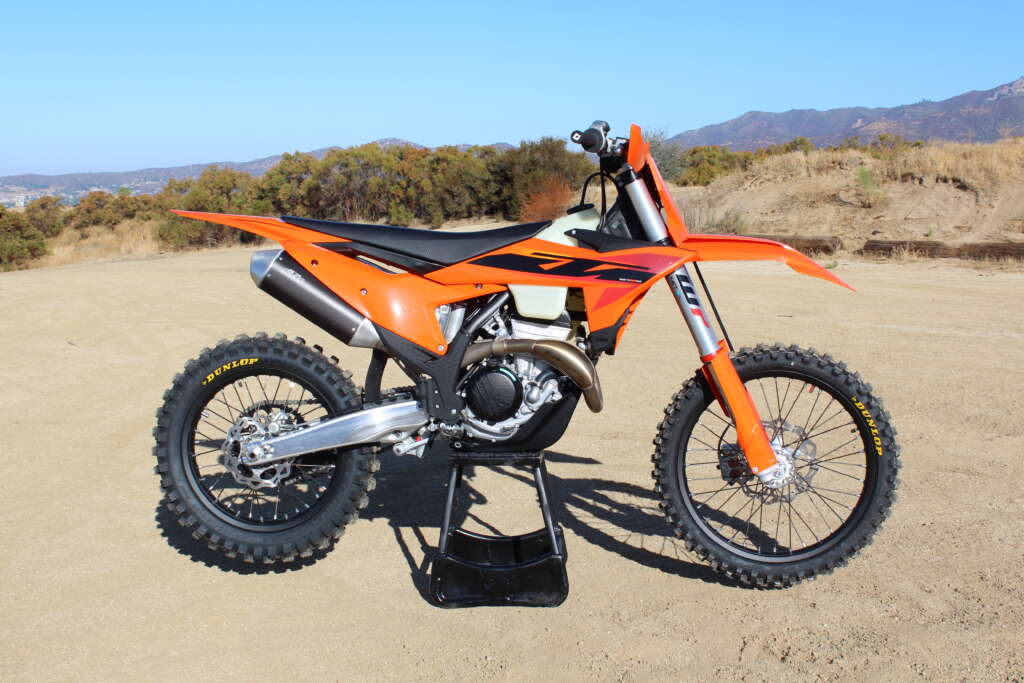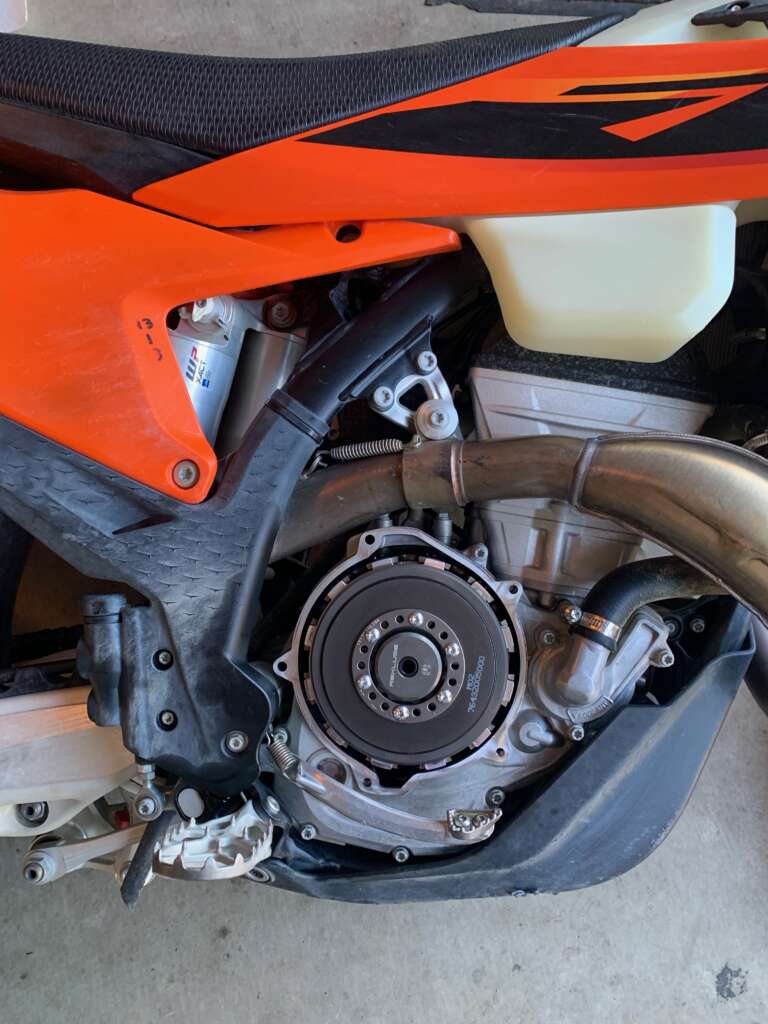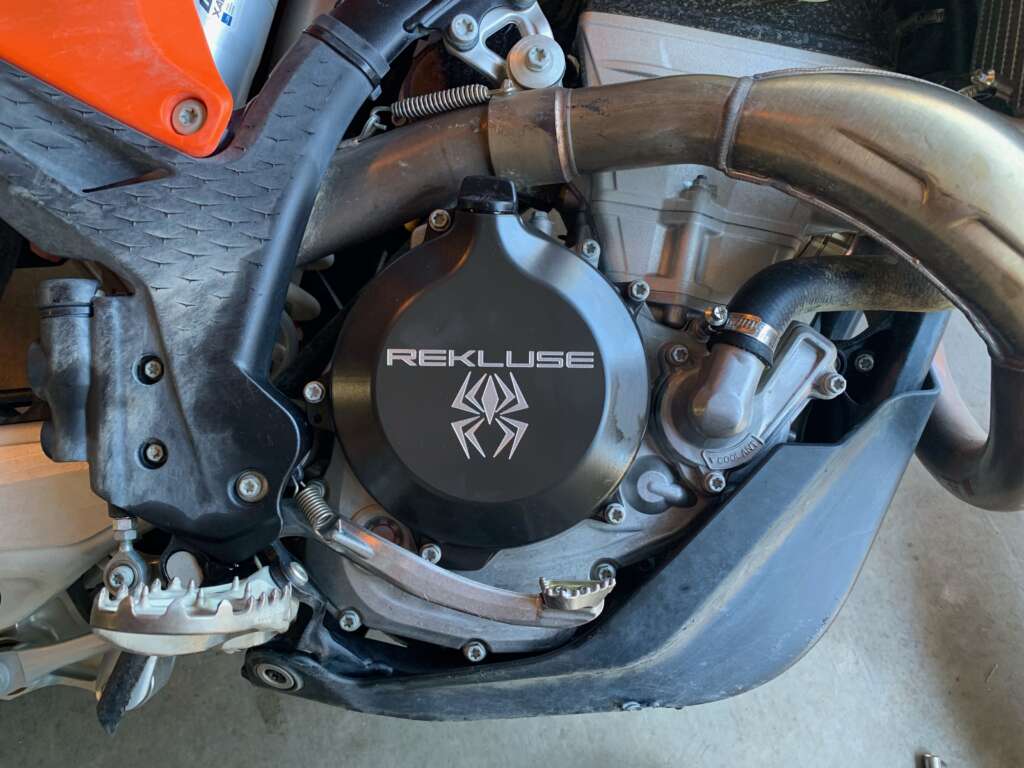Written/Tested By: Gardner Tarlow
I’ve been stoked to ride the 2025 KTM 350XCF for a good part of our SoCal off road season. I’ve had plenty of rides on my typical single track and favorite open desert places as well as most of the SoCal motocross tracks. The 350XCF has continued to perform well and has had no issues as it hits 30 hours. The original review of the bike can be found on Keeferinctesting.com. The 350XCF has performed really well from the high desert to the low desert, moderate to fast single track, weekday motocross and local GPs. The bike performs very well in its intended purposes but struggles in the extreme fringes outside of its intended purposes as a GNCC style race bike. To me, the Austrian manufacturers made a motocross specific, a cross country specific and an extreme trail specific XCW bike to cover all the fringes of the off-road sport. Obviously the SXF and XCW are the extremes for the Austrian brand and the XCF is the bike the Austrians believe that many in the middle will migrate to, in hopes of being able to do it all. Unfortunately, as good as the XCF is, it has some limitations in stock form. I would say the XCF performs more admirably as a straight up motocross bike than it does a technical single track goat trail bike. With that being said, I do not race any longer but I’m more comfortable dialing in suspension and figuring out a motocross track than I am at cleaning a technical rock section or rocky hill climb. This is where I struggle with the KTM 350XCF compared to a 2-stroke specific bike designed for single track, such as the KTM XC or XCW 2 stroke. I’m a senior vet rider, open novice speed, I ride 2-3 times a week and I’m 5’10”, 185 pounds.

For purposes of this article, I’ll only be touching on the review aspect of the stock 350XCF bike. Please see Keeferinctesting.com for the full article on the 2025 KTM350 XCF. In reviewing the 350XCF suspension, the spring fork, although a bit soft for faster motocross purposes, has performed well in all other conditions. From my novice motocross pace, to open desert and rocky trails, the forks perform very well. The spring fork feels plush and performs well in the initial stroke of the fork with small bumps, rock chatter, logs, and larger, sharp edge rocks are absorbed with confidence and predictability. The fork dampening for my weight and skill of motocross is somewhat borderline and would require stiffer valving for a faster or heavier rider. This fork is more than capable for off road purposes at my size, speed and weight. I hope with the praise the spring fork has gotten from the off-road community that the Austrian manufacturers consider making a change for one of its motocross brands and let the consumer dictate which fork is preferred. The rear shock is solid and performs well and again, outside of potential dampening for the faster, heavier riders for motocross, this setup performed well for myself in all riding conditions.
The handing of the 350XCF is kept very close to the performance level of the motocross 350SXF bike as they share many of the same frame designs and characteristics. The 350XCF handles very similarly to the Austrian 250F’s and in certain situations better because of the performance benefits of the spring fork. I had no issues with the bikes handling in any riding conditions other than a sense of the bike feeling heavier than a 2 stroke in tight, technical single track. I
The performance of the 350XCF motor performs very well on the motocross track. It requires less effort and is possibly easier to ride than a 250F on the track without having the fear or concern of a 450’s power and ending up in the bushes due to misguided judgment. The motor also performs well on open to moderate paced single tracks when the throttle is more than cracked open. The 350XCF motor in tight single track at slow speeds can feel a bit on-off or dare I say herky-jerky. Typical 2 strokes designed for single track can feel almost electric off the bottom and therefore very smooth and linear when moving through slow technical sections. To many motocross riders this electric linear motor can feel unexciting; however this is what my riding skills need when I get into slow paced, tight technical sections. I would imagine most riders who ride technical single track would agree. This is where the KTM 350XCF is out of its comfort zone for me. In attempting to use the mellow white map and traction control to clean up low speed throttle response, I would get repeated cough and stalling occurrences. When turning off traction control, the cough and stall symptom persisted in the white map and I did not see benefit using the white map. Using the green aggressive map and traction control seemed to eliminate the cough and stall symptoms but still didn’t help to slow the speed throttle response feeling. I felt options to resolve this issue lied with either a Vortex ignition with remapping or potentially a Rekluse auto clutch.

When Kris and I discussed the 350XCF performance, Kris offered for me to test a Rekluse auto clutch which I jumped at. One week later Kris gave me the Rekluse and from there I had my good friend Steve, help me install it. The directions on the website are excellent and if you are capable of doing a top end on a 2-stroke motor, you are more than capable of installing a Rekluse clutch. If you don’t know what a Rekluse cutch is, the Rekluse maintains all the typical functional benefits of a standard clutch as well as, the bike will not stall even if in gear at a standstill without the clutch engaged. As you roll on the throttle, the auto clutch engages based on RPM. The down side to this design is that if your bike is idling in gear in your garage and you wick the throttle, like we all do, you will more than likely launch your bike across the garage and potentially dent the garage refrigerator. Needless to say my wife was pissed, circa 2014, first Rekluse. With that being said, you should always start and stop your Rekluse bike with the clutch lever engaged until you are certain it’s in neutral and you have become familiar with the Rekluse.
On a more serious note, the Rekluse seemed to soften up the low-end throttle response issue the 350XCF stock bike had as well as negated the cough and stall effect of slow paced on-of throttle riding. The more you ride a Rekluse, the more you realize that you don’t need to cover the clutch or fan the clutch in or out of corners. Yes, I believe if I was racing, I would still cover or fan the clutch; however the Rekluse doesn’t require this to be done. The Rekluse theoretically performs almost all clutching scenarios without engagement of the clutch lever. With the Rekluse doing this, it is important to be aware that continuing to use the clutch lever as a standard clutch may overheat the Rekluse, as the clutch is now performing double duty.
The 350XCF with the Rekluse now provides the ability of the bike to function in a much wider scope of conditions. The Rekluse clutch still allows riders to pop the clutch to get over obstacles, just like a standard clutch. However, it also offers the added benefit of minimizing rider errors—especially when fatigued or navigating technical sections—helping to prevent stall-and-fall scenarios. On slow, technical and narrow razor backs with minimal room for error, the 350XCF motor feels more comfortable as rolling on and off throttle at low RPM doesn’t have the herky-jerky feeling. In very tight single track, instead of having to clutch constantly and having the power at times be a bit too much, you can simply roll off and on throttle. Having the deceleration effect all the way through a corner from entrance to exit can have its benefits when on trail versus track. Additionally, the Rekluse clutch allows for deceleration on steep descents. I find a standard clutch bike, when descending down hills, will skid with the rear brake and clutch engaged, and once the brake and clutch are released, the rear wheel will feel light and it will slide back and forth in a poorly controlled manner and will kick as the tranny attempts to slow the bike down. This is not the end of the world but this is the dance between clutch and rear brake we all do with a standard clutch bike. The Rekluse, since you don’t need to engage the clutch while applying the rear brake—as it will not stall—once you release the rear brake, the Rekluse reengages with the ground. Instead of the wheel kicking and sliding, the rear end squats and the transmission decelerates the bike without any bad behavior. This creates a very controlled descent and really takes the pucker out of rutted big down hills.

The KTM 350XCF definitely benefited from the Rekluse and expanded the ability of this bike to be comfortable in tight technical slow single track. There is one potential downside to having a Rekluse clutch on the trail. With a standard clutch, if you stall on a hillside, the standard bike transmission will engage and prevent the bike from rolling backwards. With a Rekluse clutch, when the bikes motor isn’t running on a hillside, the bike will roll backwards as if you have the clutch lever engaged. There are two options when this occurs – don’t stall on a steep hill or keep the motor running and use light throttle to engage the tranny to work against gravity. This technique is easy to learn however, Rekluse has designed an even better option – the Rekluse left-handed rear brake. This system is a smaller accessory lever that mounts below the clutch and uses the same hydraulic system the brake pedal uses and can be engaged for this exact purpose. This left-handed clutch can also help in rock sections allowing you to have your right foot off the peg and still activate the rear brake.
For motocross purposes, I would not typically think of using a Rekluse auto clutch on a track bike. However, I found no downside to the Rekluse clutch on the track and at times, I felt the hook up and connectivity with the ground was better oscillated by the Rekluse clutch than by my clutch hand. With the exception of consciously thinking of not abusing the clutch, I did not find any downside while riding motocross. For those who feel they would not want a Rekluse clutch as this might detune your clutch technique over time, I still believe a Vortex ignition with a map version similar to the Green aggressive map, and a very linear soft hitting map could resolve the issues I felt with the stock KTM 350XCF. The Rekluse has many benefits that every rider can benefit from. From a young apprehensive beginner to an expert, the Rekluse has its place. At the end of the day, I’m just an old guy trying to get to the end of the trail.
